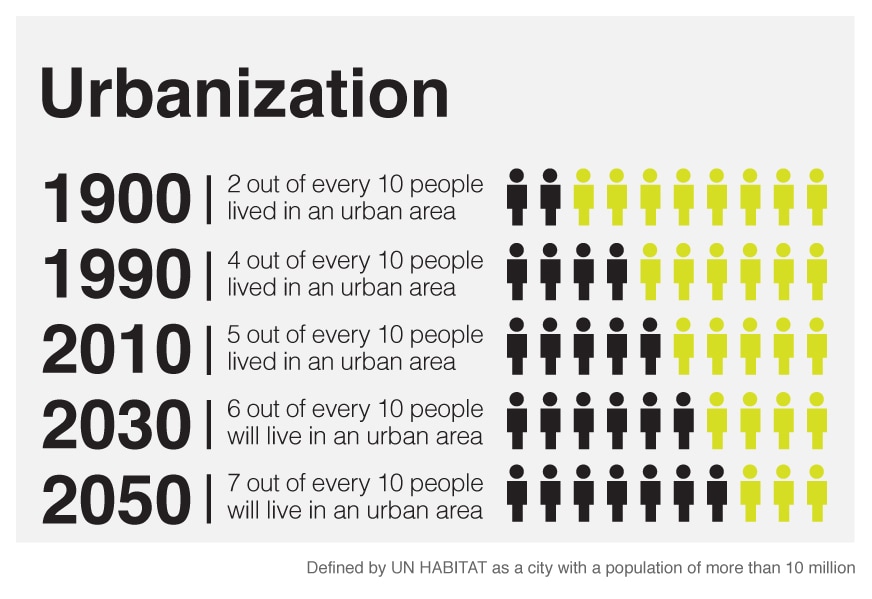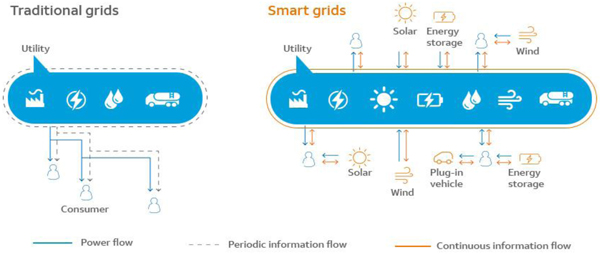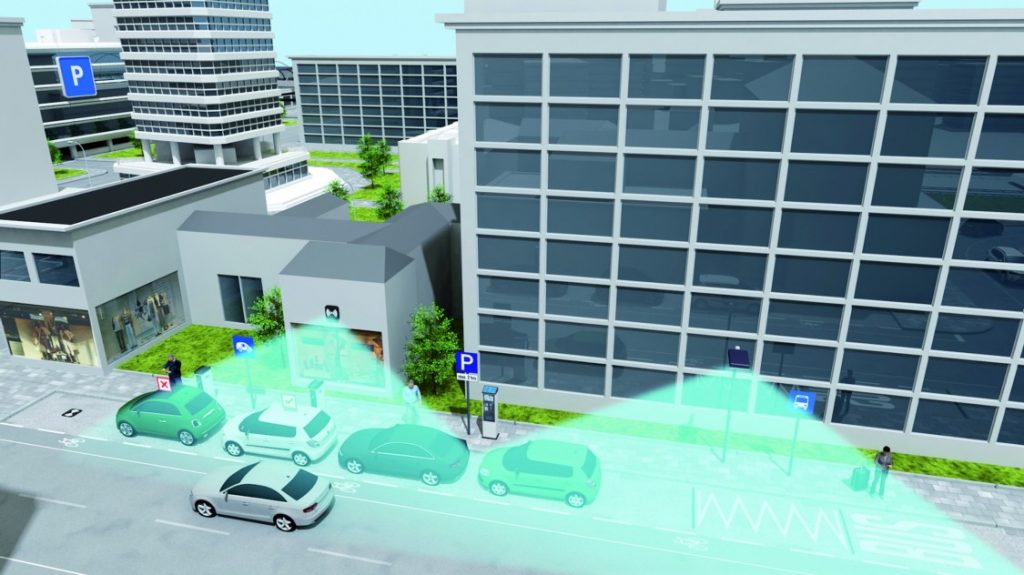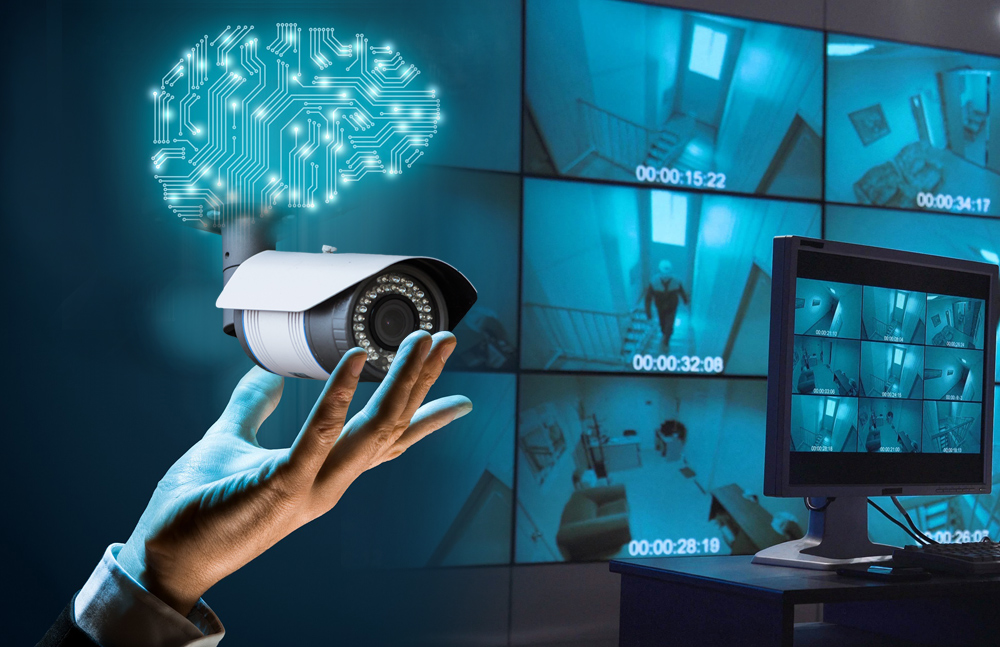Why do we even need smart cities?
The global population today is 7.8 billion and 58% of that lives in urbans areas. According to the United Nation the figure is expected to increase to 68% by 2050. Urbanization can have positive impacts such as improving the quality life of people moving out from rural areas, however a rapid urbanization requires well managed cities otherwise the results could be devastating.

What’s the bad side of urbanization?
Sharing your toilet with hundreds of people would look unreal to us but that’s reality in Ethiopia. Looking at the capital of the country, Addis Ababa, where 80% of the current population is still living in slums, alongside with an annual urbanization rate of around 5.4% we can sadly say that the problem will intensify unless we do something. In addition, cities such as New York and Hong Kong are also dealing with major congestion problems. For example, an overpopulation could lead to extreme traffic, pollution and depletion of resources. We need to see this as the perfect opportunity to harness AI and IoT technology in order to improve urban life and achieve better city planning by facilitating a more efficient ecosystem.

What exactly is a smart city?
A smart city is a city that uses technology to provide services and solve major city problems such as the ones mentioned before. Even though the term is relatively new and there still isn’t a universally accepted definition of it, we can identify it as a framework composed of the following technologies:
- Information and communications technology (ICT)
- Connected physical devices using the Internet of Things (IoT) network
- Geographical information systems (GIS)
Each of the above technologies work together to collect and contextualize enormous amounts of data. However, these technologies are meant to be used as a tool and it’s not them that define the city as a smart. This tool is used to collect data in real time about different kinds of things such as traffic, air and water quality but the key element of such city is the participation of its citizens and the idea is centered around them creating the city and not the other way around.
The role of AI
We need to harness AI technologies in order to analyze the growing volume of data being collected by all sensors we previously mentioned. Machine learning, neural network capabilities and data analytics can and should be used on these “Big Data” collected by sensors and extract actionable insight for better decision-making regarding city planning. For instance, in Amsterdam waste collection vehicles have smartphones mounted on, which capture and stream images of the streets conditions and using AI technologies the municipality can quickly detect hazardous situations such as roads being blocked by construction waste.
Use cases of AI in smart cities
Energy Efficiency
A traditional power grid as we all know it, is designed as a one-directional system sending power to our homes and offices. A smart grid in contrast, is a highly automated power transmission network which allows information and energy to flow from each node and provides real-time monitoring and adjustments. Two of the main features of such grids are the self-repair and the two-way interaction with the user. Smart grids can automatically diagnose and restore power supply in case of a power outage as well as reduce the power failure frequency. Another great benefit of these grids is that we as consumers can be updated in real-time whether the power demand is low and cost is cheap, and plan our energy usage more efficiently. Wouldn’t be great if we were actually able to know when demand and energy cost is low and plan our laundry accordingly?

Another great example is smart street lightning. Chicago is undertaking one of the largest smart lightning programs and aim to replace 85% of streetlights with high-quality LED fixtures, saving the city an estimated $10M a year in energy costs. These LED lights will provide a more reliable outdoor lightning by dimming when no cars or people are around and at the same time improve safety and reduce energy costs. AI is the backbone of a true smart grid and will be the one taking into account millions of variables and data points such as weather, demand and location and proactively decide where the electricity for each house will come and how much it will cost. AI can make the decisions that need to be made.

Smart Parking & Traffic control
Finding a parking spot in crowded urban cities could be a frustrating process for drivers and with a 10% increase of population living in urban cities by 2050, this creates some challenges. ParkEagle, a Dutch company proving smart parking services in the Netherlands, states some interesting facts about traffic in urban cities:
- 63% of drivers avoid travelling to a destination because of the challenge to find a possible parking spot.
- 30% percent of urban traffic is caused by drivers looking for a parking spot (Cleverciti, another company that provides smart parking solutions for smart cities, also states that 30% of traffic is unnecessary).
- 55 hours are wasted on average by a single drivers per year just driving around to find a parking spot.
What is interesting is that this company states that there is no lack of parking spots. According to ParkEagle, the real problem is caused by a lack of information on available parking spots.
The above-stated facts do not contain all the current problems of traffic as we know nowadays in urban cities. More consequences of driving around just looking for a parking spot could be redundant greenhouse gas emission from cars, more costs for drivers such as fuel costs and more possible littering from cars.
What are the solutions that smart parking provides in smart cities?
Providing insight into parking spots. The biggest benefit of smart parking in smart cities is that is provides insights for drivers into where parking spots are available. These insights could be made possible for example with the use of cameras or sensors in the roads. Information of available and occupied parking spots could for example be shown to drivers in a mobile app. This makes it easy for drivers to plan their car travel in advance by clicking on an available parking spots before driving. This action would cause the app to show the shortest or quickest route to an available parking spot in the form of navigation instructions. The calculations behind providing the nearest parking spots could be made possible with the use of AI. This solution solves multiple problems: Frustrating process of finding an available parking spots, unnecessary traffic on the roads, higher fuel costs caused by inefficiently looking for a parking spots
Smart Displays. Another form of providing insights into parking spots is made possible by indoor or outdoor smart displays. These displays could show at a glance to drivers if there are parking spots available in the direction that the drivers are headed into. When there are no parking spots available, the display could for example suggest a route to take for the drivers to find a parking spot, which is a form of traffic control. An example of an indoor display could be a display placed inside a parking garage of a mall which displays the amount of available parking spots on a single level at a glance. Beside quickly and efficiently finding a parking spots, this could also improve customer satisfaction for customers that use the parking garage for specific shops.
Automatic number plate recognition. This is a service provided by smart parking, a company providing multiple smart parking solutions, in which cameras are able to register the license plate of a car. Automatic number plate recognition (ANPR) could serve multiple purposes:
- Identifying off-parked cars. Cars that are parked at curfews or other unallowed locations could be registered.
- Identifying cars that are parked in a set time parking location. Cars which are parked longer then allowed at a specific location could be registered.
- Identifying cars that are parked in a wrong location. It occurs that regular drivers occupy parking spots destined for business staff. Such cars could be registered.
- Identifying cars which have a permit to park in a certain location. Only cars with a license plate registered on a list for example could be allowed into a certain area.
- Identifying cars of which the driver did not initiate a paying action.
In all of the above situations, ANPR is able to register a car’s number plate whereafter the driver could be fined or warned by mail.
Global warming. A final but not unimportant thing to mention is that cars emit greenhouse gasses. These same gasses are the cause of a well-known problem, namely the global warming problem. The climate agreement of the Netherlands which aims to create a more sustainable and healthier environment, states that it has the goal to reduce greenhouse gas emission by 50% in 2030 compared to 1990. This percentage should be 95% already in 2050. Smart Parking luckily leads to less traffic. This could in turn help reach the goal of the climate agreement, thereby also reducing the pressure on the industry for reducing greenhouse gas emission.

Public safety & Security
CCTV cameras are used world-wide to monitor different kinds of areas. From parking spots to malls, or from parks to busy streets; CCTV cameras are used basically everywhere. Although they provide the basic functionality of being able to monitor a specific area, they are pretty primitive devices. The footage needs to be monitored by humans and the cameras are only able to capture video.
In a smart city, CCTV cameras could exist at the exact location as we know nowadays. They would just be coupled with some sensors and Artificial Intelligence software. The main difference with our current CCTV cameras is that they could have more functionality than only being able to record video.
What are the possibilities with Smart CCTV cameras?

Face recognition. Coupled with Artificial Intelligence, CCTV cameras could be able to detect and register individual faces. Using face recognition, wanted criminal could suddenly be registered with any camera around the world. Since there will be 1 billion CCTV camera’s in the world by the end of this year, this a very nice function to have. Another application of face recognition would be to detect drivers that use their phone while driving. Detecting these drivers leads to them being fined.
Computer vision. Computer vision is a field within Artificial Intelligence which focuses on how computers can gain useful insights from photos and videos. The possibilities of computer vision are a manifold. Computer vision could for example detect hazards should as fires. By detecting a smoke, a CCTV camera could predict/conclude that there is a fire somewhere. Combining certain video images and a sound could for example be a signal for danger. An example could be a camera detecting glass and the sound of screaming people. With AI software, the conclusion could be made that there is a certain danger in an area.
Automation. Using Computer Vision and more forms of Artificial Intelligence, CCTV camera’s could cause that staff are no longer needed to monitor footage. Instead, they could detect a variety of dangers, such as fires or criminals, and then send a signal to the appropriate civil servant to look into a certain situation. This dramatically shortens the amount of time between an event happening that is registered by a CCTV camera and people intervening because of the registered situation. In a unpleasant situation nowadays, a person would need to personally monitor the footage itself, often even after an amount of time.
Combating terrorist attacks
A significant weakness of overcrowded cities is that they are vulnerable to terrorist attacks. Methods have been developed for detecting and classifying extremist related social-media content. According to a study tweets can be classified into two categories: extremist and nonextremist classes by using Artificial Intelligence technologies. The performance evaluation resulted in Deep Learning achieving 92.66% accuracy in identifying extremist tweets. However, there are only few studies about preventing terrorist attacks and a number of challenges arise regarding the use of AI in countering terrorism including human rights and practical implications.

Smart City Challenges
Security and hackers. More technology doesn’t necessarily mean more cybersecurity. One of the biggest concerns when talking about technologies that rapidly grow is none other than security. Smart security projects need to be safe and due to the increased vulnerabilities cities need new cyber security guidelines. Atlanta for example was held hostage to a massive ransomware cyber-attack back in 2018 which shattered many devices at City Hall for about five days. Thankfully, despite the breach, 911 system and its emergency response were unaffected but it significantly impacted law enforcement by even forcing police officers to complete paper forms by hand. However, one thing we can learn from Atlanta is that security must be one of the top priorities when designing a smart city.
Transparency. Smart cities are designed for their citizens which means that they play the primary role and they need to be engaged in the project as much as possible. Even though not all of their suggestions might be implemented, citizens need to be a part of the definition of the project. Trust between government and citizens can only be achieved through an ultimate transparency. Education in Artificial Intelligence is a requirement however in order for people to be able to understand all the different ways these sensors collect data and how these data are then processed.
Privacy. Last but not least, maybe the hardest thing to achieve when planning a smart city is probably protecting the privacy of their citizens and at the same time encouring data sharing. An ExpressVPN survey conducted in 2020 found that 92% of Americans would delete an app they regularly use if it were caught selling their data and about two-thirds would pay to delete their digital footprint from the internet forever. People no longer trust Big Tech after they have been constantly caught abusing their data and the real question now is who can we trust with our data.
Concluding, AI would be a great addition in planning our future smart cities but along with multiple benefits, there are still some major drawbacks that need to be adressed. We hope that the public and the governments will manage to align with each other and focus on using smart technologies for improving our urbal life.


